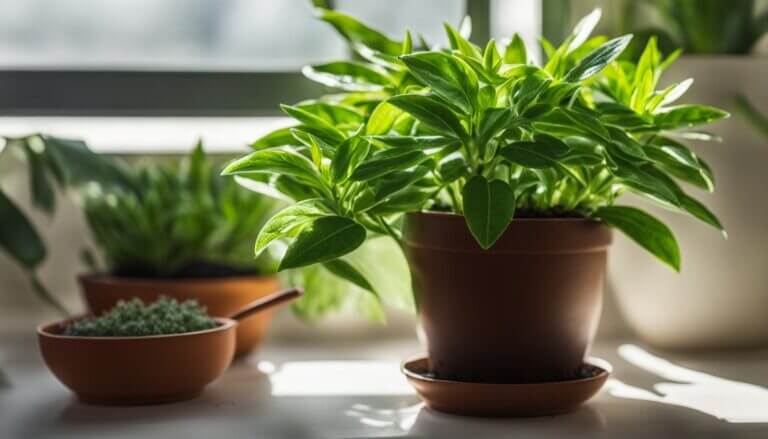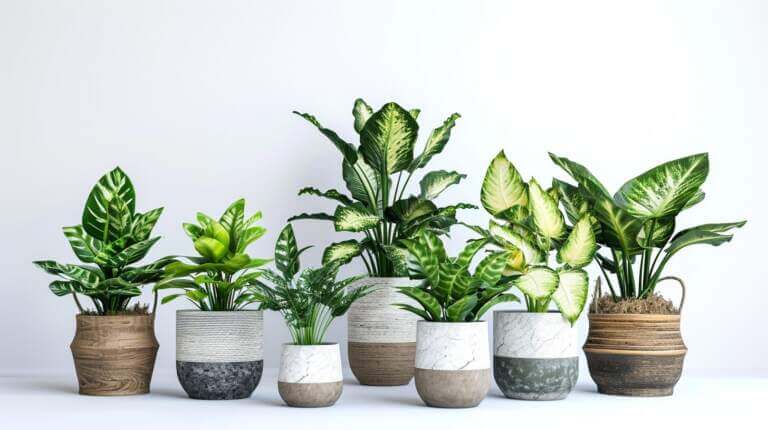Fittonia, also known as nerve plant, is a tropical plant with decorative foliage. If the leaves of your nerve plant are curling, it could be due to a variety of factors. Inconsistent watering is one of the most common causes of leaf curling in nerve plants. Other factors include overfeeding with fertilizer, lack of nutrition, depleted soil, impaired soil pH, temperature stress, root rot from overwatering, poor water quality, too much or too little light exposure, insect infestation, low humidity, soil type, and pot size. By identifying the specific cause of the issue, you can take the necessary steps to diagnose and treat your nerve plant.
Key Takeaways:
- Inconsistent watering is a common cause of leaf curling in nerve plants.
- Overfeeding with fertilizer can lead to leaf curling.
- Temperature extremes and low humidity can also cause leaf curling.
- Determining the underlying cause is crucial for effective diagnosis and treatment.
- Proper care and adjustments in watering, feeding, temperature, and humidity can help resolve the issue.
Underwatering and Leaf Curling
Underwatering is a common cause of leaf curling in nerve plants. Fittonia naturally thrives in moist forest environments, so it’s important to ensure that the soil is always slightly moist. If the soil becomes dry, the roots are unable to provide enough water to the leaves, causing them to wilt and curl. To fix this issue, regularly check the moisture level of the soil and water the plant when the top inch feels dry. Trim any yellow leaves to prevent further damage and avoid placing the plant in direct sunlight.
Proper watering techniques are crucial for the health of your nerve plant. It’s important not to overwater or underwater the plant, as both can lead to leaf curling. When watering, make sure to thoroughly saturate the soil, allowing excess water to drain away. This helps to prevent waterlogged roots, which can result in root rot and leaf curling. Using a well-draining potting mix specifically formulated for tropical plants can also help maintain proper moisture levels.
In addition to regular watering, maintaining a consistent humidity level can also prevent leaf curling. Nerve plants prefer high humidity environments, so misting the leaves with water or placing a humidity tray nearby can help create the ideal conditions. Avoid placing the plant near drafts or air conditioning vents, as they can dry out the leaves. By providing adequate moisture and humidity, you can help your nerve plant thrive and prevent leaf curling.
Signs of Underwatering in Nerve Plants:
- Leaves wilting and curling
- Dry soil that pulls away from the edges of the pot
- Yellowing or browning of leaves
- Stunted growth
How to Fix Leaf Curling Due to Underwatering:
- Check the moisture level of the soil regularly
- Water the plant when the top inch of soil feels dry
- Thoroughly saturate the soil, allowing excess water to drain away
- Trim any yellow leaves to prevent further damage
- Avoid placing the plant in direct sunlight
- Maintain a consistent humidity level by misting the leaves or using a humidity tray
| Causes of Leaf Curling | Symptoms | Treatment |
|---|---|---|
| Underwatering | Leaves wilting and curling | Regularly check moisture level of soil, water when top inch feels dry, trim yellow leaves, avoid direct sunlight, and maintain humidity |
| Overfeeding | Excess salts and nitrogen accumulation | Flush out excess salts with distilled water, replace chemical fertilizers with organic compost, and consider transplanting |
| Temperature Stress | Damage to leaf tissue | Maintain temperature around 20°C (70°F), avoid cold water, and prune dead stems and leaves |
| Low Humidity | Drying out of leaves | Increase humidity with pebble tray or humidifier, avoid air conditioners and heat generators, and mist leaves regularly |
Overfeeding and Leaf Curling
Overfeeding your nerve plant with fertilizer can lead to leaf curling. Excess salts and nitrogen from overfertilization can accumulate in the soil, preventing the roots from absorbing water properly. This can result in leaf dehydration and curling. To fix this issue, flush out the excess salts by leaching the soil with distilled water. Replace chemical fertilizers with organic compost to provide balanced nutrition to the plant. If your nerve plant is severely affected, consider transplanting it into fresh soil.
Proper fertilization is important for the health of your nerve plant, but overfeeding can have detrimental effects. The excess nutrients can disrupt the balance in the soil, causing the roots to struggle with water absorption. This can lead to the curling of the leaves and overall dehydration of the plant. By being mindful of the amount and frequency of fertilizer application, you can prevent this issue from occurring.
The Impact of Overfeeding on Nerve Plant
“Overfeeding your nerve plant with fertilizer can disrupt the natural balance and prevent the roots from absorbing water properly, resulting in leaf curling and dehydration.”
When addressing the problem of overfeeding and leaf curling, it is crucial to leach the soil to remove the excess salts and nutrients. This can be done by pouring distilled water through the soil until it drains out from the bottom of the pot. Repeat this process a few times to ensure thorough leaching. Additionally, switching to organic compost can provide a more balanced nutrition for the plant, reducing the risk of leaf curling. If the issue persists or if the plant is severely affected, consider repotting the nerve plant into fresh soil to give it a fresh start.
| Causes of Leaf Curling due to Overfeeding | Fixing the Issue |
|---|---|
| Excess salts and nitrogen from overfertilization | Flush out the excess salts by leaching the soil with distilled water |
| Disruption of water absorption by the roots | Replace chemical fertilizers with organic compost for balanced nutrition |
| Leaf dehydration and curling | Consider repotting the plant into fresh soil for a fresh start |
Temperature Stress and Leaf Curling
Temperature stress can be a significant factor contributing to leaf curling in nerve plants. Fittonias prefer warm tropical temperatures, and exposure to extreme cold can cause damage to the leaves, resulting in curling. It’s important to ensure that your nerve plant is kept in a suitable environment to prevent temperature-related stress.
To fix leaf curling caused by temperature stress, it is recommended to maintain a temperature of around 20°C (70°F) for your nerve plant. Avoid placing the plant near drafty windows or in areas with fluctuating temperatures. Additionally, avoid watering the plant with cold water as it may further stress the leaves.
In case your nerve plant has been exposed to cold temperatures and is experiencing leaf curling, it is advisable to prune any dead or damaged stems and leaves. This will help redirect the plant’s energy towards healthy growth. Remember that prevention is key, so it’s essential to provide your nerve plant with the appropriate temperature conditions from the start to avoid leaf curling.
Creating a suitable temperature environment for your nerve plant contributes to its overall well-being and can help prevent leaf curling. By maintaining a consistent temperature and providing proper care, you can ensure that your nerve plant thrives and displays its vibrant foliage.
Low Humidity and Leaf Curling
Low humidity can be a common culprit behind leaf curling in nerve plants. These tropical beauties thrive in high humidity environments, as they are native to rainforests. When the humidity levels are low, the leaves of your nerve plant can dry out and curl, causing distress to the plant.
To fix this issue, there are a few simple steps you can take to increase the humidity around your nerve plant. One effective method is to place your plant on a pebble tray filled with water. The water evaporates, creating a moist microenvironment around the plant. Another option is to use a humidifier, which can release moisture into the air and create a more suitable humidity level for your nerve plant.
Avoid placing your plant near air conditioners or heat generators, as these can further decrease the humidity in the surrounding area. Additionally, misting the leaves of your nerve plant regularly can help to hydrate the plant and prevent leaf curling. Be sure to use room temperature or slightly warm water when misting, as cold water can shock the leaves.
By providing your nerve plant with the right humidity levels, you can help it thrive and maintain its beautiful foliage. Remember, a happy plant is a healthy plant!
FAQ
Why are the leaves of my nerve plant curling?
The leaves of your nerve plant may be curling due to a variety of factors such as inconsistent watering, overfeeding with fertilizer, lack of nutrition, depleted soil, impaired soil pH, temperature stress, root rot from overwatering, poor water quality, too much or too little light exposure, insect infestation, low humidity, soil type, and pot size.
How do I fix leaf curling caused by underwatering?
To fix leaf curling caused by underwatering, make sure the soil is always slightly moist. Check the moisture level regularly and water the plant when the top inch of soil feels dry. Trim any yellow leaves and avoid placing the plant in direct sunlight.
What should I do if overfeeding is causing leaf curling in my nerve plant?
If overfeeding is causing leaf curling, flush out the excess salts by leaching the soil with distilled water. Replace chemical fertilizers with organic compost to provide balanced nutrition. Consider transplanting the plant into fresh soil if it is severely affected.
How can I prevent temperature stress from causing leaf curling in my nerve plant?
To prevent temperature stress from causing leaf curling, keep your nerve plant in a location with a temperature around 20°C (70°F). Avoid watering with cold water and prune any dead stems or leaves to promote healthy growth.
How can I increase the humidity to prevent leaf curling in my nerve plant?
To increase humidity, place the plant on a pebble tray filled with water or use a humidifier. Avoid placing the plant near air conditioners or heat generators that can decrease humidity. Regularly misting the leaves can also help hydrate the plant and prevent leaf curling.







